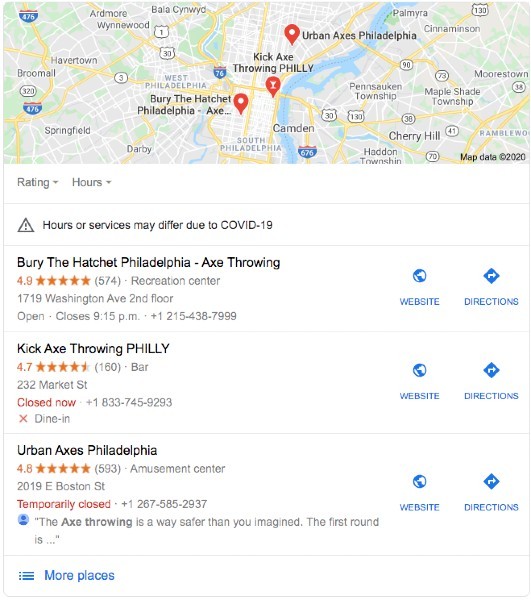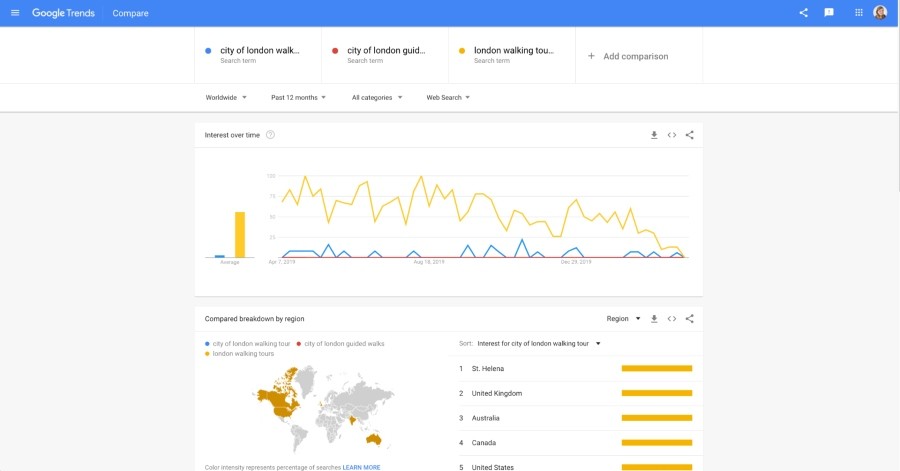When it comes to marketing your tours or activities, one of the most important facets is search engine optimization (SEO). As the biggest driver for organic traffic, SEO can help you rank for popular travel and tourism keywords in your destination — whether in Google Search, Google Maps, or other online directories — to capture interested travelers and locals alike.
While travel related keywords are very common, what makes them highly valuable is the intention behind them. Typically, the traveler has an end goal; they already know what they want to do, they’re just looking to book with the right tour operator.
For example, let’s say someone wants to go wine tasting in Italy for a bachelorette trip. Instead of entering “best bachelorette party ideas for big groups” into Google, they might try something like, “wine tour Venice Italy.” Understand the difference?
You see, they’re primed to book already. After weeks of travel planning, they’ve had time to look up ideas, and now, just need to find a winery tour operator to host the party. But sometimes, people make last-minute travel plans while in-destination; it’s almost instinctive. “What do you want to do today? Go kayaking? Gotcha. Looking up a place to rent kayaks right now.”
And more often than not, they will go with a business in Google’s local snack pack (see image below) or the first page of results. Usually, that’s because they like what they see right away, are in a hurry, assume the best choices are in the top positions, or the reason is a combination of all three.

When done right, SEO can help you snag those higher rankings and increase your chances of capturing high-converting leads at such a crucial time. There are lots of advanced travel SEO tactics, but we’re going to start by going over finding the best tourism keywords, as they should become the basis for all of your optimization efforts.
What are tourism keywords?
Tourism keywords are the search terms or phrases people use to find things to do in your destination. They normally contain a niche descriptor and a geographical modifier, following a structure that tends to look like this:
Niche descriptor + Geographical modifier = tourism keyword
whale watching tour + Victoria BC = whale watching tour Victoria BC
In terms of SEO, you can add relevant travel and tourism keywords to your website content, Tripadvisor listing, and even your YouTube channel, to tell search engines (mostly Google) and other directories that your business offers what the searcher is specifically looking for.
But of course, there isn’t a one-size-fits-all for travel keywords. Every searcher is unique, and so is their go-to phrasing, which means there could be hundreds of variations for the same search intent.
For example, someone might replace the location with term near me instead:
escape rooms + near me = escape rooms near me
Another searcher might throw in modifiers like best, top, cheapest:
best + mountain bike rentals + Virgin Utah = best mountain bike rentals Virgin Utah
And finally, someone might switch up the order altogether:
surfing + Bondi Beach + lessons = surfing Bondi Beach lessons
So, how do you know what travel and tourism keywords to use? Which ones are the most popular to get the most clicks? And what competition will you face — do you even have a chance at ranking for them? That’s where local keyword research comes into play.
How to find keywords for tourism website
Without taking the time to research the top travel keywords for your destination, you’re essentially taking a shot in the dark for SEO. If you wouldn’t do that in an axe throwing competition, why would you do that for something that matters as much as your brand’s online visibility?
That said, doing a keyword search by city is a simple process — involving nothing more than brainstorming with online keyword tools — and doesn’t take too long once you get it down pat. The objective is to generate an extensive list of all potential keywords so that you can quickly compare for best use cases. Here are the steps:
1. Create a travel keywords list
First things first, you will want to create a spreadsheet for your keyword ideas to live. That way, you can quickly refer to it whenever you publish new content, like a blog post or web page. Just remember to keep it updated, considering keyword trends change all the time. We’ll get to that soon.
For the most part, your keyword spreadsheet will only need three columns: local keyword, search volume, and competition. But since many keywords, local included, are long-tail keywords — highly specific phrases of three words or more — it’s a good idea to set it up like below to get a better understanding of the structure commonly used:

Long-tail keyword: the full keyword, with or without a geo modifier (location)
Search volume: the average monthly searches for a specific keyword
Competition: the level of competition between advertisers bidding on the keyword — like online travel agents (OTAs)
Prefix: the word(s) that come before the seed keyword
Seed keyword: the industry-related keyword, or better put, the keyword that describes your product — such as bus tour, kayak rentals, lake cabins, or aerial ropes course
Suffix: the word(s) that come after the seed keyword
2. Brainstorm with Google and other keyword tools
One of the best places to begin your local keyword research is Google itself. You might have noticed already that Google will autocomplete your search as soon as you type, make predictions in a dropdown menu, and provide a list of related searches at the bottom of the search engine results page (SERP).
Well, you can actually use these suggestions as a jumping-off point because Google comes up with them based on related and popular keywords for a better search experience. So if you start by entering a few search terms you would use yourself to find your offerings (not brand specific), you will end up finding relevant keywords to add to your spreadsheet.
On top of that, you can find out what queries your guests already use to discover your business with Google Search Console. As long as you have a Google Account, you can enter your domain, then click on Google Search Results under Performance and see what queries get the most clicks and impressions. You can also filter the results on a per-page basis by clicking +New, then Page, and pasting your page URL.

Once you have a list going, you can then turn to an online keyword tool for more insight. There are many options available that come with powerful features and databases — like Ahrefs Keyword Explorer or SEMrush Keyword Magic Tool. However, Google Ads Keyword Planner is free and does a good enough job.
Here’s how to use Google Keyword Planner

- Access Google Keyword Planner by clicking on Go to Keyword Planner
- Follow the prompts to set up a Google AdWords account. Don’t worry, you won’t have to run an advertising campaign to use the keyword tool.
- Select the box with Discover new keywords
- Copy and paste your keywords separately into the search bar and click Get results. You can broaden the search by using multiple seed keywords, separated by commas.
- Record the average monthly searches and competition for the keyword in your spreadsheet
- Scroll through the keyword ideas and add any more to your list that also apply to your business
Now, if you run your tourism operation in a location that doesn’t have a high population, you might not see any results because there just isn’t enough data available. If that’s the case, try replacing your geo modifier with another city nearby, and then make the switch back in your spreadsheet.
For example, nothing much comes up in Keyword Planner for Half Moon Bay boat tours, even though there are over 7 million results in Google Search. But if we use San Francisco instead, which is 29.4 miles away, we get 89 keyword recommendations that we can adapt for Half Moon Bay keywords.
3. Choose the top keywords for tourism
After you feel like your keyword list is long enough, you can go ahead and choose your top picks. And the easiest way to do this is by sorting the search volume column from lowest to highest.

But wait, shouldn’t it be the other way around? Don’t you want to target travel related keywords with the highest search volume? Normally, yes. However, as a small business, you have a better chance of ranking for low volume keywords — around the 10-100 range.
That’s because high volume keywords are highly competitive. It only makes sense; popular keywords attract more competition because they drive more search traffic. And unfortunately, larger companies tend to earn these rankings because they’ve already built the SEO-strength for an extra boost.
Keep in mind though, while low volume keywords get less search traffic, they usually have higher conversion value because they are more specific. So targeting them is actually a strategic move on your part, and as you improve your SEO overall, you can eventually go after the higher volume keywords, too.
Also, Google Trends is another useful and free tool for choosing the best keywords. You can compare up to 5 similar keywords and their popularity overtime, so that you know which ones to focus on more. Note: If you don’t see anything come up, try filtering the results by your country instead of worldwide.

4. Repeat the process for each tour
If you have multiple products, you will want to find travel related keywords for all of them. For example, let’s say you offer a city bike tour, but also a brewery bike tour. Although both fall in the same category and have the same seed keyword (bike tour), a person looking to book a city bike tour nearby won’t use the same search term as they would for the latter.
Just add a new sheet in your keyword spreadsheet for each of your products and repeat the above steps. The same goes for if you have multiple locations — but for better organization, you may want an entirely new spreadsheet for each site and its products.
Where to put travel and tourism keywords
For the best SEO practice, you should have a different keyword theme for each page on your website. Since your homepage will likely rank best for your brand name, you can optimize your booking page(s) with your travel keywords. Besides, that’s where it makes the most sense to direct traffic, considering most local searches have a transactional intention.
Again, if you have multiple locations, categories, and products, you should consider having a separate booking page for each. That way, you can really target those tourism keywords by giving Google and other search engines a clear idea of what every booking page is specifically about.
With the previous example, you would optimize your category booking page with the local seed keyword, bike tour Dublin, and then list all of your bike tours with call-to-action buttons to their separate booking page. Doing this will also improve your internal linking structure for better overall SEO. From there, every product booking page could then target long-tail keywords.
Here all the places to put travel and tourism keywords on your booking page(s):

- Page title: also known as a title tag, it’s an HTML element that specifies the title of your booking page, which appears in the search results and the browser window
- Meta-description: a snippet of around 160 characters that also displays in the SERPs and describes what your booking page is about
- Heading: the main title at the start of your booking page with the H1 tag
- Sub-headings: the section headings of your booking page with an H2, H3, or H4 tag — the best places for your keyword synonyms
- Body text: the main content of your booking page, usually where you have paragraph sections
- Item name: the name of one of your products in tours, activities, accommodation or rentals
- Item description: the description for tours and travel, which includes essential details
- URL slug: the part of the URL that comes after your primary domain that identifies your booking page — like pinehighzipline.com/zipline-tours
- Image alt-text: a description of the image that gets read-aloud for the visually impaired with screen readers or appears when the picture doesn’t load. It should be short, but descriptive
- Image filename: a sneaky place to optimize your content, which can also help your image appear in Google Images, like saving an image as london-ghost-walking-tour.jpg rather than IMG-12.jpg.
It’s easy to get carried away when adding keywords to travel websites. What you want to avoid is keyword stuffing, which is an old blackhat SEO tactic that Google penalizes today. Instead, you should focus on working your travel and tourism keywords naturally into your page content and switching up your keyword usage with the various synonyms in your local keyword list.
Understandably, it might feel unnatural to put your location everywhere, especially in the headings, sub-headings, and item names. And that’s alright; you don’t have to, seeing as you can also put your NAP on every page for optimal SEO.
Don’t forget about your NAP
Your NAP is your business info, which includes your Name, Address, and Phone Number. On your website, the best place for your NAP is in the footer. You should put your NAP somewhere on every page, but if you have multiple locations, make sure to assign the appropriate address for that specific booking page.
One of the most common SEO problems is neglecting to keep your NAP consistent and up-to-date across the board, from your website to your Google My Business listing, even on your Facebook Business Page. Maintaining consistency in your citations signals to Google that you are a legitimate business and care about giving your guests accurate information.
Other places for tourism keywords
Tourism keywords don’t just belong on your website. As I mentioned earlier, you can optimize your local listings and social media profiles with them as well. But we’ll get to that more in the second chapter of the Local Marketing Guide for Experience Providers. Get your free copy below!
Ready to target travelers who are nearby?

Get 52 pages of local marketing tips
And learn all about what you can do to stand out in your community and local search results.



